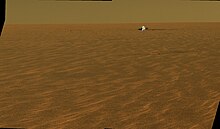
Back Meridiani Planum Catalan Meridiani Planum Czech Meridiani Planum German Meridiani Planum Spanish Meridiani Planum Estonian فلاته نیمروز Persian Meridiani Planum French Meridiani Planum Galician מישור מרידיאני HE Meridiani Planum Croatian
 Mars Exploration Rover Opportunity looks across the smooth soil of Meridiani Planum, towards the discarded heat shield of the rover's lander | |
| Feature type | Plains |
|---|---|
| Coordinates | 0°2′S 3°8′W / 0.033°S 3.133°W[1] |
| Diameter | ~1 060 km[1] |
| Eponym | Latin merīdiānus |
Meridiani Planum (alternatively Terra Meridiani) is a large plain straddling the equator of Mars. The plain sits on top of an enormous body of sediments that contains bound water. The iron oxide in the spherules is crystalline (grey) hematite (Fe2O3).
The Meridiani Planum is one of the most thoroughly investigated regions of Mars. Many studies were carried out by the scientists involved with NASA's Mars Exploration Rover (MER) Opportunity. Two outstanding features found by these investigations are the actions of water flow and aqueous chemistry in this plain's geological history and, particularly specific to the plain, an abundance and ubiquity of small spherules composed mainly of grey-hematite that sit loosely on top of the plain's soils and underneath embedded inside its sediments. The loose surface spherules were eroded out of the sediments. They are informally called "blueberries". The plain's sediments have extremely high sulfur content (as sulfates) and high phosphate levels.
The boundaries of the Meridiani Planum are not firmly fixed and accepted by the community of Mars planetary scientists. However, the boundaries of the hematite-bearing plain were operationally defined in the late 1990s and early 2000s by the extent of the orbital detection of the plain's surface hematite by the thermal emission spectrometer (TES) on the satellite Mars Global Surveyor.[2][3][4][5][6] The various names for this region (i.e., Terra Meridiani, Meridiani Planum) started to be used in the published literature in 2002/2003/2004.[3][4][5] Each name reflects the coincidental (somewhat arbitrary) fact that the plain straddles the prime meridian for the system of longitude lines introduced for east/west Mars mapping.
The area covered by the detected surface hematite is around 150,000 km2,[5] i.e., larger than Lake Superior (82,000 km2 (32,000 sq mi)) in North America. Except for transport by large meteor impact, loose surface spherules tend to remain within a few meters of their starting embedded location.[7] The surface hematite spherules and sediments are coextensive in surface area. So, the area extent of the underlying sediments is at least as large as the area of detected surface hematite spherules but likely somewhat larger since, for example, a significant area of surface hematite was covered by ejecta from the Bopolu Crater impact.[6] The typical depth of the underlying sediments is several hundred meters.[3][6][8] The Meridiani plain's sediments overlay older geological formations that appear around the sediments' boundary.[4] The plain's sediments and surface hematite spherules were formed in three geological epochs and by three different sets of geological processes (more below).
The MER Opportunity rover investigated the rim of Endeavour Crater from August 2011 until the rover's demise in 2018. The plain's sediments do not cover this crater rim and are geologically younger than this rim. As such, the rim of Endeavour Crater is distinct from the plain, although it is surrounded by the plain and its sediments.
- ^ a b "Meridiani Planum". Gazetteer of Planetary Nomenclature. USGS Astrogeology Research Program. (Center Latitude: -0.04°, Center Longitude: 356.86°)
- ^ Christensen, P. R.; Bandfield, J. L.; Clark, R. N.; Edgett, K. S.; Hamilton, V. E.; Hoefen, T.; Kieffer, H. H.; Kuzmin, R. O.; Lane, M. D.; Malin, M. C.; Morris, R. V.; Pearl, J. C.; Pearson, R.; Roush, T. L.; Ruff, S. W.; Smith, M. D. (2000). "Detection of crystalline hematite mineralization on Mars by the Thermal Emission Spectrometer: Evidence for near‐surface water". Journal of Geophysical Research: Planets. 105 (E4). American Geophysical Union (AGU): 9623–9642. Bibcode:2000JGR...105.9623C. doi:10.1029/1999je001093. ISSN 0148-0227.
- ^ a b c Hynek, Brian M.; Arvidson, Raymond E.; Phillips, Roger J. (2002). "Geologic setting and origin of Terra Meridiani hematite deposit on Mars". Journal of Geophysical Research: Planets. 107 (E10). American Geophysical Union (AGU): 5088. Bibcode:2002JGRE..107.5088H. doi:10.1029/2002je001891. ISSN 0148-0227.
- ^ a b c Arvidson, R. E.; Seelos, F. P.; Deal, K. S.; Koeppen, W. C.; Snider, N. O.; Kieniewicz, J. M.; Hynek, B. M.; Mellon, M. T.; Garvin, J. B. (2003-10-18). "Mantled and exhumed terrains in Terra Meridiani, Mars". Journal of Geophysical Research: Planets. 108 (E12). American Geophysical Union (AGU): 8073. Bibcode:2003JGRE..108.8073A. doi:10.1029/2002je001982. ISSN 0148-0227.
- ^ a b c Christensen, Philip R.; Ruff, Steven W. (2004). "Formation of the hematite‐bearing unit in Meridiani Planum: Evidence for deposition in standing water". Journal of Geophysical Research: Planets. 109 (E8). American Geophysical Union (AGU). Bibcode:2004JGRE..109.8003C. doi:10.1029/2003je002233. ISSN 0148-0227.
- ^ a b c Arvidson, R. E.; Poulet, F.; Morris, R. V.; Bibring, J.‐P.; Bell, J. F.; Squyres, S. W.; Christensen, P. R.; Bellucci, G.; Gondet, B.; Ehlmann, B. L.; Farrand, W. H.; Fergason, R. L.; Golombek, M.; Griffes, J. L.; Grotzinger, J.; Guinness, E. A.; Herkenhoff, K. E.; Johnson, J. R.; Klingelhöfer, G.; Langevin, Y.; Ming, D.; Seelos, K.; Sullivan, R. J.; Ward, J. G.; Wiseman, S. M.; Wolff, M. (2006-11-22). "Nature and origin of the hematite‐bearing plains of Terra Meridiani based on analyses of orbital and Mars Exploration rover data sets". Journal of Geophysical Research: Planets. 111 (E12). American Geophysical Union (AGU). Bibcode:2006JGRE..11112S08A. doi:10.1029/2006je002728. ISSN 0148-0227.
- ^ Fenton, Lori K.; Michaels, Timothy I.; Chojnacki, Matthew (2015). "Late Amazonian aeolian features, gradation, wind regimes, and Sediment State in the Vicinity of the Mars Exploration Rover Opportunity, Meridiani Planum, Mars". Aeolian Research. 16. Elsevier BV: 75–99. Bibcode:2015AeoRe..16...75F. doi:10.1016/j.aeolia.2014.11.004. ISSN 1875-9637.
- ^ Edgett, Kenneth S. (2005-11-02). "The sedimentary rocks of Sinus Meridiani: Five key observations from data acquired by the Mars Global Surveyor and Mars Odyssey orbiters". The Mars Journal. 1. Mars Informatics: 5–58. Bibcode:2005IJMSE...1....5E. doi:10.1555/mars.2005.0002. ISSN 1548-1921.
